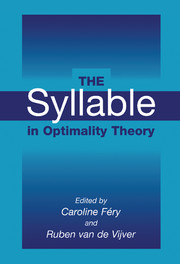Book contents
- Frontmatter
- Contents
- List of Contributors
- Preface
- The Syllable in Optimality Theory
- Part One INTRODUCTION
- Part Two SYLLABLE STRUCTURE AND PROSODIC STRUCTURE
- Part Three NONMORAIC SYLLABLES AND SYLLABLE EDGES
- Part Four SEGMENTS AND SYLLABLES
- 11 On the Sources of Opacity in OT: Coda Processes in German
- 12 Ambisyllabicity and Fricative Voicing in West Germanic Dialects
- 13 The CiV-Generalization in Dutch: What Petunia, Mafia, and Sovjet Tell Us about Dutch Syllable Structure
- 14 The Relative Harmony of /s+Stop/ Onsets: Obstruent Clusters and the Sonority Sequencing Principle
- Part Five HOW CONCRETE IS PHONOTACTICS?
- Author Index
- Languages Index
- Subject Index
11 - On the Sources of Opacity in OT: Coda Processes in German
Published online by Cambridge University Press: 03 July 2009
- Frontmatter
- Contents
- List of Contributors
- Preface
- The Syllable in Optimality Theory
- Part One INTRODUCTION
- Part Two SYLLABLE STRUCTURE AND PROSODIC STRUCTURE
- Part Three NONMORAIC SYLLABLES AND SYLLABLE EDGES
- Part Four SEGMENTS AND SYLLABLES
- 11 On the Sources of Opacity in OT: Coda Processes in German
- 12 Ambisyllabicity and Fricative Voicing in West Germanic Dialects
- 13 The CiV-Generalization in Dutch: What Petunia, Mafia, and Sovjet Tell Us about Dutch Syllable Structure
- 14 The Relative Harmony of /s+Stop/ Onsets: Obstruent Clusters and the Sonority Sequencing Principle
- Part Five HOW CONCRETE IS PHONOTACTICS?
- Author Index
- Languages Index
- Subject Index
Summary
Introduction
Optimality Theory (OT) is built on output constraints. These constraints impose conflicting demands on candidates and are all violable, with precedence regulated by universal and language-particular ranking specifications (see Prince and Smolensky 1993). As a result, constraints are minimally violated in winning candidates. An output-oriented theory of this kind needs to pay special attention to patterns of phonological opacity, arising out of generalizations that apparently need to be stated at some nonsurface level of representation. Opacity constituted a central object of study in traditional generative phonology. In terms of the relevant portions of Kiparsky's (1973: 79) definition in (1) that formed the basis of most subsequent work on the topic, two different types of opacity can be distinguished.
(1) A phonological rule P of the form A → B / C̲D is opaque if there are surface structures with any of the following characteristics:
a. Instances of A in the environment C—D
b. Instances of B derived by P that occur in environments other than C̲D.
On the one hand, there are patterns built on generalizations that are overtly violated in some output forms ((1a)); on the other hand, there are patterns built on generalizations whose environment is only covertly fulfilled (not in the output, but in some other representation associated with the output representation, derivationally or otherwise (1b)).
- Type
- Chapter
- Information
- The Syllable in Optimality Theory , pp. 271 - 303Publisher: Cambridge University PressPrint publication year: 2003
- 17
- Cited by



